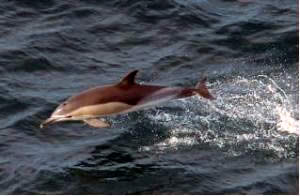
Common dolphin in the Bay of Biscay. Credit: Copyright Clive Martin / BDRP
Researchers from the wildlife conservation charity Marinelife are extremely concerned about what it is NOT seeing this summer in the Bay of Biscay.
Marinelife's unique long-term monitoring project, the Biscay Dolphin Research Programme (BDRP) has been conducting scientific monthly whale, dolphin and seabird surveys through the English Channel and Bay of Biscay for the last 13 years, using the P&O Cruise Ferry, The Pride of Bilbao, as a research platform. In addition, a BDRP full-time Wildlife Officer collects daily data on dolphin abundance. The BDRP surveys have detected more than 20 species of whale and dolphin in the Bay of Biscay and counted over a hundred thousand animals.
Through the recent work of BDRP and other research groups, the Bay of Biscay has become known as a worldwide hotspot for whales, dolphins and seabirds with many passengers each year experiencing wonderful encounters with the marine wildlife, especially groups of dolphins that may number several thousand. However, this summer there has been a very obvious and worrying dearth of sightings, which is significant given that the Bay of Biscay is of European importance for dolphins and other cetaceans.
Early indications have shown that during June and July, the total number counted of the 3 main dolphin species, Common Dolphin, Striped Dolphin and Bottlenose Dolphin, are down by around 80% on the same time last year. Seabirds, such as auks, shearwaters, and gannets have also been in short supply and the situation has been ongoing since the early spring, with no signs of an improvement thus far during August.
Marinelife are worried that this very apparent decline in sightings of both dolphins and seabirds along the ferry route, could be more wide-ranging and could indicate a big reduction in fish stocks due to over fishing or a change in distribution of fish stocks due to temperature changes (in turn linked to climate change). This year has already been marked by a failure of the anchovy fishery, with bans being put in place for the Spanish and French fleets, but what else could be happening?
Marinelife's Research Director, Dr Tom Brereton said: "Whatever the cause of the disappearance of dolphins this summer, it shows both how vulnerable they are and how alarmingly quickly local declines can occur when environmental conditions change. The changes highlight how we need to act quickly, to address major issues such as climate change and over-fishing."
Marinelife are also well aware of the other pressures facing dolphins, especially those in Biscay and the Western Approaches to the English Channel and that too is related to commercial fishing – namely bycatch of dolphins in fishing nets. This activity is known to claim thousands of dolphins each year, many washing up dead on the beaches of the south west coastline and this situation has still not been adequately addressed by the fishing industry.
Marinelife continues to work in partnership with a number of other research groups, spearheading an international initiative, the Atlantic Research Coalition (ARC) that aims to describe changes in the status of whales and dolphins at European scale.
